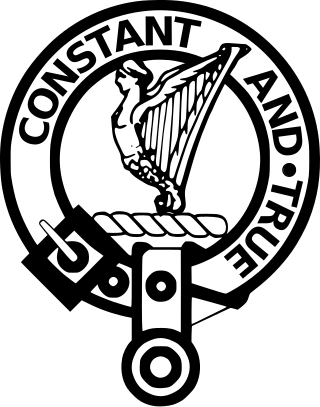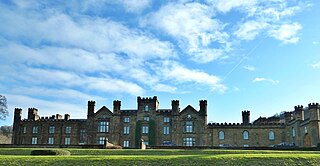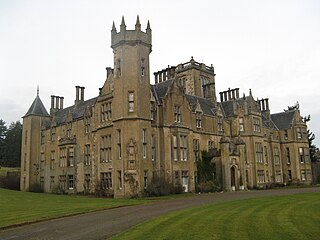
Lennoxlove House is a historic house set in woodlands half a mile south of Haddington in East Lothian, Scotland. The house comprises a 15th-century tower, originally known as Lethington Castle, and has been extended several times, principally in the 17th, 19th and 20th centuries. The house is protected as a category A listed building, and is described by Historic Scotland as "one of Scotland's most ancient and notable houses." The wooded estate is included on the Inventory of Gardens and Designed Landscapes in Scotland, the national listing of significant gardens.

Clan Rose is a Scottish clan of the Scottish Highlands.

Elie and Earlsferry is a coastal town and former royal burgh in Fife, and parish, Scotland, situated within the East Neuk beside Chapel Ness on the north coast of the Firth of Forth, eight miles east of Leven. The burgh comprised the linked villages of Elie to the east and to the west Earlsferry, which were formally merged in 1930 by the Local Government (Scotland) Act 1929. To the north is the village of Kilconquhar and Kilconquhar Loch.
There have been three baronetcies created for members of the Anstruther family, two in the Baronetage of Nova Scotia and one in the Baronetage of Great Britain. Two of the creations are extant while one is extinct.

Sir John Anstruther, 4th Baronet and 1st Baronet PC was a Scottish politician.

Sir John Anstruther, 1st Baronet was a Scottish politician who sat in the Parliament of Scotland from 1702 to 1707, and in the British House of Commons from 1708 to 1741.

Sir John Anstruther, 2nd Baronet was a Scottish industrialist and politician.

Clan Carmichael is a Scottish clan and is also considered a sept of the Clan Douglas, Clan MacDougall, Stewart of Appin, and Stewart of Galloway.
The title of Lord Pittenweem is a Scottish title of nobility. It was created by James VI as a barony in 1609 for Frederick Stewart, son of William Stewart, Commendator of Pittenweem. Fredrick Stewart assigned the title and lands of the Lordship and Barony to Thomas Erskine, Viscount Fenton, later 1st Earl of Kellie, in 1614. Between 1631 and 1672 the Lordship and Barony was held by the Crown. It was held "in place of the late lords" so that when the Barony and Lordship later passed to the 3rd Earl of Kellie it was not as a new creation but by an assignation of the Lordship and Barony.
Sir John Carmichael-Anstruther, 5th and 2nd Baronet was a British Member of Parliament for Anstruther-Easter Burghs between 1811 and 1818. He was the eldest son of Sir John Anstruther of that Ilk, 4th and 1st Bt. (1753–1811) and Maria Isabella Brice. He was educated at Eton and Christ Church, Oxford and admitted to Lincoln's Inn in 1806.

Balcaskie is a 17th-century country house in Fife, Scotland. It lies around 2 km north of St Monans, and is notable chiefly as the home and early work of architect Sir William Bruce.

Newark Castle is a ruin located just west of St Monans, on the east coast of Fife, Scotland. The building, built in the 15th century, stands in a dramatic location, overlooking the North Sea. The upper storeys are ruinous, but vaulted cellars survive, hidden from view.

Sir Ian Fife Campbell Anstruther, of that Ilk, 8th Baronet of Balcaskie and 13th Baronet of Anstruther, Hereditary Carver of the Sovereign, Hereditary Master of the Royal Household in Scotland, Chief of the Name and Arms of Anstruther FSA was a baronet twice over. He inherited substantial property interests in South Kensington and wrote several books on specialised areas of 19th-century social and literary history.

Craigiehall is a late-17th-century country house, which until 2015 served as the Headquarters of the British Army in Scotland. It is located close to Cramond, around 9 km (5.6 mi) west of central Edinburgh, Scotland.

Wilton Castle is an early 19th-century mansion, built on the site of a medieval castle, now converted into residential apartments, situated at Wilton, in Redcar and Cleveland, North Yorkshire, England. It is a Grade II listed building.
Sir William Anstruther, Lord Anstruther was a Scottish judge.

Balcarres House lies 1km north of the village of Colinsburgh, in the East Neuk of Fife, in eastern Scotland. It is centred on a mansion built in 1595 by John Lindsay (1552–1598), second son of David, 9th Earl of Crawford. The house became the family seat of the Earl of Crawford. The present house is the result of substantial extensions in the early nineteenth century, using part of a fortune made in India, but preserves much of the original mansion.

Forglen House is a mansion house that forms the centrepiece of the Forglen estate in the parish of Forglen, north-west of Turriff, Aberdeenshire, in the north-east of Scotland. The lands were given to the abbots of the Abbey of Arbroath by King William the Lion before 1211 and the Monymusk Reliquary was held there. The original castle, built around 1346, was replaced by a vernacular harled house that was later extended. Significant development of the estate began when it was acquired by the family of Lord Banff and they started the work of landscaping and planting trees. It became their main family seat during the 18th century. After the death of William Ogilvy, the eighth and final Lord Banff, the estate passed by marriage to the Abercromby baronets who continued to enhance the property and maintained it as their main residence. Sir Robert Abercromby, 5th Baronet commissioned the Aberdeen City Architect, John Smith to design the present house in 1839.

James Balfour was a Scottish nabob who became a landowner and politician. The son of a prosperous and influential Scottish gentry family, he became a trader in India. Having made a fortune supplying the Royal Navy, he returned to Scotland to buy several landed estates, including Whittingehame in East Lothian where he built a classical mansion.

Inch House, a former country house situated within Inch Park in Edinburgh, Scotland is a category A listed building. The oldest part, a Scottish vernacular L-plan tower house, dates from the early 17th century. From 1660 it was owned by the Gilmour family, who arranged for additions and extensions to the house in the 18th and 19th centuries. It was sold to the then Edinburgh Corporation in 1945. Since then it has been used as a primary school and more recently as a community centre.

















